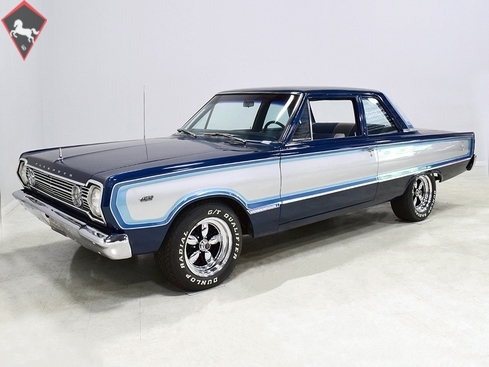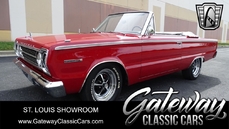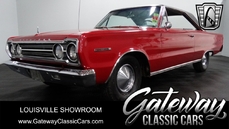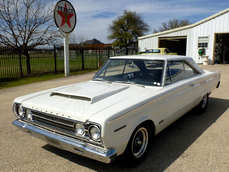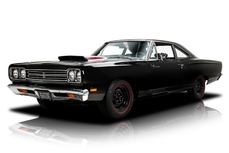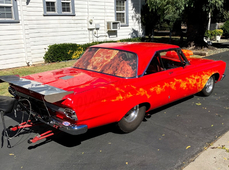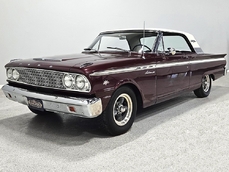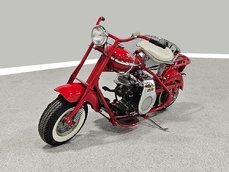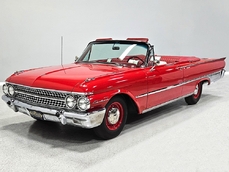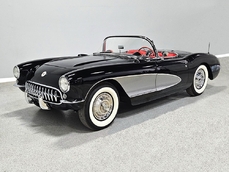Plymouth Belvedere 426 cubic inch HEMI V8 1966
General description :
Chrysler introduced their 426 HEMI V8 for racing in 1964 and it was suddenly a very different game on the tracks across the country. But building a legend took more than racetrack wins—you had to translate it to showroom sales. So in 1966, the Street Hemi debuted, a mildly de-tuned 426 cubic inch monster, still topped with twin 4-barrel Carter carbs and cranking out a somewhat underrated 425 horsepower. That was some serious go-power in 1966. And remarkably, you could just order yourself a HEMI in just about any Dodge or Plymouth model you wanted. Some went the stylish route with a Satellite hardtop but if you were serious about going fast, a plain-Jane Belvedere 2-door sedan was the smart choice. Lighter, stiffer, and cheaper than the others, it was the smart weapon of choice when you were prowling the streets looking for a fight in 1966.
Those hardcore guys buying the Belvedere 2-door sedan were few, as only 156 were built and only 57 of those were backed by a TorqueFlite transmission—a pretty rare piece. This EE1 Dark Blue Belvedere shows only 30,165 miles, a figure we believe is authentic. It spent almost the entirety of its life in the Pacific northwest so it’s untouched by the ravages of a rust belt winter and aside from some updated seat covers and the custom paint job on the sides of the car, it’s almost entirely original. It was discovered a few years ago by an enthusiast looking for an unusual early HEMI of some kind, and he found it by intentionally mis-typing various model names into his search engine—sometimes guys didn’t know how to spell and it represents a kind of opportunity. Sure enough, this Plymouth Belvadere [sic] showed up in his search and he was able to pick it up without having to fight off a bunch of other enthusiasts. It spent the first part of its life as a fair-weather toy and show car; despite being built for combat, it doesn’t appear to have ever really turned a wheel in anger. The bodywork is laser-straight and in excellent condition, and while the Belvedere sedan bodywork won’t win many beauty contests, it’s purposeful and the paint job enhances what’s already there—check out the way the custom stripes wrap around the rear window. This car was built after January 1, 1966 (March 3,1966) so it wears ‘426 HEMI’ badges on the front fenders instead of the earlier ‘HP2’ badges, and there’s enough chrome to make it look well-dressed. It’s all in excellent original condition with no evidence of previous accident damage or trauma. Heck, the thing even feels tight.
The interior isn’t 100% stock, wearing a set of custom seat covers that were probably installed when the paint was done in the ‘80s and some slightly plusher carpets. The rest, however, appears original, including the tooled door panels, dash pad, and headliner, and the steering wheel is in good condition underneath the leather wrap. Factory gauges include all the vitals, and are joined by a trio of vintage Stewart-Warner instruments that include an oil temperature gauge and which were probably installed when the car was almost new. Buckets and a console were added at some point, and the only options appear to be the HEMI V8 and a Music Master AM radio in the dash. It’s all in excellent condition and it all works except the radio, which isn’t a surprise (and you probably won’t miss it once you hear the HEMI rumble to life). The trunk is obviously massive and includes a newer trunk mat and you can see that the tire well underneath is in excellent condition.
That’s all nice, but the Street HEMI was about performance and this car delivers. Chrysler wasn’t doing matching-numbers in the traditional sense in 1966, but all the clues suggest that this is the car’s original engine and don’t worry, it is a real H-code car. It has been detailed and upgraded with a deeper oil pan and an upgraded Mallory ignition system, but otherwise remains stock. A pair of Carter AFB carburetors feeds it from a correct air cleaner assembly and the crinkle-coated valve covers give this big engine its nickname, “The Elephant.” And it lives up to its name Street HEMI by being easy to start with a decent idle and good manners when you’re just out driving rather than looking for a fight. It stays cool and if you keep your foot off the floor it doesn’t act like the era’s nastiest powerplant. Of course, there’s always torque on tap and just a gentle squeeze of the accelerator launches it forward without any apparent effort. For full-throttle runs, you need to make sure the path ahead is clear, because that massive engine has no problem with the relatively lightweight bodywork.
The undercarriage is original and in fantastic shape with no evidence that this car has seen winter weather. There’s no rust or rot in any of the structural areas and aside from some surface scale on a few heavy metal parts, it’s in excellent shape. The TorqueFlite 3-speed automatic transmission is virtually indestructible and has great street manners behind the big HEMI. Out back, the 8.75-inch rear end has been recently serviced with bearings and seals, and with 3.54 gears inside, the Street HEMI lives up to its name of being usable in the real world. It’s punchy but cruises at 70 MPH on the highway. Manual steering and manual drum brakes were part of the deal when you were buying a car built for combat. Long-tube headers dump into a newer stock-style exhaust system, so it has a nice rumble that never gets annoying and since it’s a full-sized B-body, ride quality is excellent and handling is mediocre. It surely came with plain steel wheels when it was new, but it’s currently wearing a set of perfectly vintage Cragar mags with 235/60/15 white-letter radials that probably date to the ‘80s.
The HEMI has all kinds of mythos around it, but we’ve found that this very solid, clean, and unrestored Street HEMI is very easy to live with. On the other hand, the legend is legit, because this is a ferociously fast car if you get on it. That’s probably why it remains at the top of so many enthusiasts’ wish lists even 50 years after it went out of production. This isn’t a show car or a points car, but the world is full of perfect cars. This is a HEMI you can drive and enjoy as intended without worries, a car that’s beautifully sorted and properly tuned, and which drives right. You don’t have to be afraid of cracking the throttle, just so long as it’s aimed where you want it to go. Call today!
Harwood Motors always recommends and welcomes personal or professional inspections on any vehicle in our inventory prior to purchase.
1966 Plymouth Belvedere 426 cubic inch HEMI V8 is listed for sale on ClassicDigest in Ohio by Harwood Motors for $67900.
Car Facts
Car type : Car Make : Plymouth Model : Belvedere Model Version : 426 cubic inch HEMI V8 Engine size : 0.0 Model Year : 1966 Location : Ohio Vehicle Registration : Undefined
67900 $
People who viewed this Plymouth Belvedere also viewed similar Plymouth listed at ClassicDigest
Other cars listed for sale by this dealer
About Plymouth
The Plymouth brand had a significant impact on the automotive industry from its inception to its eventual discontinuation. Here is an overview of Plymouth, covering its history, notable models, and specifications:Early Years and Foundation:
Origins (1928): Plymouth was introduced by Chrysler Corporation as an affordable mid-level brand, targeting budget-conscious consumers.
Success Factors: It gained popularity due to its dependable engineering, affordability, and clever marketing campaigns.
Notable Models:
Plymouth Road Runner (1968-1980):
Iconic Muscle Car: Known for its performance, affordability, and minimalist design.
Specifications: Offered various V8 engine options with power ranging from 335 to 390+ horsepower.
Plymouth Barracuda (1964-1974):
Muscle Car Competitor: Positioned as a sporty competitor in the muscle car segment.
Specs: Engine options included V8s with power output varying between 145 to 425+ horsepower.
Plymouth Fury (1955-1978):
Longevity: One of Plymouth's longest-produced models, available in various body styles.
Technical Features: Engine options included V8s with power ranging from 215 to 375+ horsepower.
Plymouth Valiant (1960-1976):
Compact Car: Introduced as a compact car, known for its durability and reliability.
Engine Specifications: Featured inline-six and V8 engines with power ranging from 100 to 235+ horsepower.
Decline and Demise:
Later Years: Plymouth faced challenges due to brand dilution within Chrysler Corporation and increasing competition from other brands.
Discontinuation: The brand struggled in the 1990s amid corporate restructuring and declining sales. Plymouth ceased production in 2001 as part of DaimlerChrysler's streamlining efforts.
Legacy and Impact:
Plymouth's legacy lies in its contributions to the American automotive landscape, offering reliable, affordable, and stylish vehicles. While it faced challenges in its later years and ultimately ceased production, several of its iconic models, especially those in the muscle car era, remain celebrated among collectors and enthusiasts, leaving an enduring mark on automotive history.
